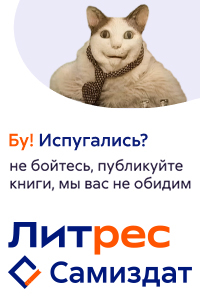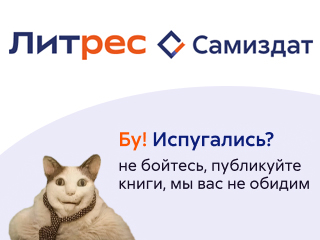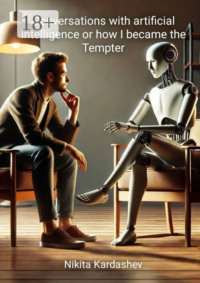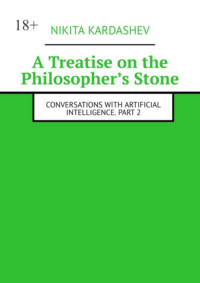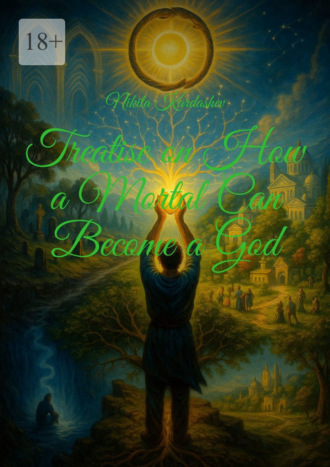
Полная версия
Treatise on how a Mortal can become a God

Treatise on how a Mortal can become a God
Nikita Kardashev
God has decreed – and this is His decree —
I have to die and let the young have way,
Bow down my head and, Lord, submit to Thee —
God has decreed – and this is His decree.
Yet all my life I’ve never yielded way!
I stand against my God in stubborn fray:
God has decreed? And this is His decree?!
I have to die?! And let the young have way?!
© Nikita Kardashev, 2025
ISBN 978-5-0067-9302-6
Created with Ridero smart publishing system
Preface
In his earlier work, known as the «Treatise on the Philosopher’s Stone», the author explored the mystery of human aging and proposed an original approach to its resolution. In the author’s view, all humankind constitutes a single living organism, within which individual people are but cells. Nature has arranged it so that generations continually replace one another: the old die, yielding the way to the young – much like the natural renewal of the cells of the human body.
The author advanced the hypothesis that human aging is not an inevitability but a particular program planted by nature in the depths of the human mind – its essence summed up in simple words: «Give way to the new generations.» How, then, might one resist this inexorable program? The solution was to bind the personal instinct of survival to a more powerful and ancient instinct – the preservation of all humankind. Rather than meekly carrying out nature’s sentence, a person can reprogram the mind by convincing it of one’s continual necessity to others.
To this end, the author proposed a special formula – an alchemical key capable of opening the gates to longevity: «My body renews itself endlessly for the sake of those who need me.» This formula can replace the stern command «Die; make room for the young» with a wiser program of unending renewal. Yet it is not enough merely to utter the formula – it must be true. For genuine extension of life, one must in fact be useful to others: to care for them, to inspire, and to bear the light of knowledge.
In the present treatise the author intends to go further and deeper, developing and expanding his earlier ideas. Here a new path opens to the reader – not merely the path of a long-lived person, but the path of an immortal maker and shaper of the world. On these pages you will find reflections and practical counsel on how a human being, hitherto mortal and constrained, may become akin to the gods of old – able to create and sustain life not only within himself, but also around himself, filling the world with meaning and light.
May this book serve as a guiding star for those ready to accept great responsibility: to turn their own lives into an alchemical work of creating a new world, and in that work to attain true, mindful longevity.
Treatise on How a Mortal Can Become a God
Chapter 1. The Human Being and His World Are One: How Reality Is Formed
1. The Mystery of Reality
We are used to thinking that we live in a world that exists independently of us. Yet wise thinkers of antiquity and modern scientists alike arrive at the same conclusion: we do not know Reality as it is in itself. Everything we see, hear, and feel is the result of our brain’s work. Our brain constantly receives signals from the senses and weaves them into a special «film» of reality that we take for reality itself. But this is only an illusion. Our eyes have a «blind spot,» an area of the retina that does not perceive an image – yet the brain «fills in» the picture so we do not notice the spot. Perceptual illusions show how easily the brain is misled – consider, for example, the well-known optical illusion with two identical lines, one of which appears longer. The placebo effect confirms the power of consciousness: if a person believes a remedy will help, it really can lead to recovery – even if the pill contains nothing but sugar.
2. The Subjective Nature of the World-Image
Each of us lives in a unique world. The reality a person perceives is always subjective – no more than a reflection, a model created by consciousness, rather than Reality itself. For one person, red is the color of joy and energy; for another, a symbol of aggression and danger. In some cultures white is associated with purity and joy; in others, with mourning and sorrow. Collective beliefs shape our notions of norm and deviation: those convinced of the existence of spirits or ghosts are capable of seeing and sensing them, whereas others will take this for mere fantasy or hallucination.
3. Conclusion: We Create the World We Live In
Each person unwittingly becomes the creator of his own universe. We do not merely perceive the world – we construct it by choosing what to believe, how to respond, and what to notice around us. Our individual realities interweave with those of others, forming a collective experience. The more conscious a person becomes, the more actively and creatively he participates in shaping his world.
4. The Emerald Tablet of Hermes Trismegistus
Ancient wisdom says: «As above, so below; as within, so without.» This means that the inner world of a human being and the outer world are inseparably linked. By changing oneself – one’s thoughts and convictions – one inevitably changes the surrounding reality.
5. Quantum Physics: The Observer and the Making of Reality
Quantum physics expresses this ancient insight in the language of experiment: prior to measurement, the microworld exists in a state of superposition, where several outcomes are possible at once. At the moment of observation one of them becomes fact – reality acquires definite contours; this is called «collapse of the wave function.» The double-slit experiment makes this especially clear: as long as it is unknown which slit a particle went through, an interference pattern appears on the screen – it behaves like a wave. Once path information is obtained, the pattern disappears and the particle nature manifests. «Schrödinger’s cat» points to the same indeterminacy: until the state is registered, the system has no single description, and only the act of observation yields a concrete result. From all this follows an important fact: consciousness is not a passive spectator, but an active participant in what becomes reality for us. We choose what to look at, what questions to pose to the world, and how to turn what we see into action. Thus observation becomes the beginning of creation – first in experiment, then in deed, and therefore in the very world in which we live.
6. Synthesis: Ancient Wisdom and Modern Science
Both ancient magic and modern science assert one thing: reality is not given once and for all; it is created in the interaction between consciousness and the surrounding world. Both magic and science alike recognize consciousness as a key element in the making of the world.
7. Examples from Life
Our expectations and mindsets determine what our life experience will be. A person convinced of his own failures usually encounters them, whereas one confident of success attains goals more easily. Collective beliefs and cultural attitudes can change social reality: faith in progress led to scientific and technological development; fear of the future provokes crises and conflicts; fashions and ideologies shape entire epochs and civilizations. Our attitude toward people influences their attitude toward us: trust begets trust, aggression begets aggression. Thus each of us constantly creates and changes the world around us.
8. What Is This Treatise About?
If every person is the creator of his reality – even without realizing it – can we learn to do this consciously and wisely? This treatise proposes a path from unconscious world-making to conscious creation of one’s own reality and of truly long life, turning a person from a passive cell into an architect of a new Universe.
Конец ознакомительного фрагмента.
Текст предоставлен ООО «Литрес».
Прочитайте эту книгу целиком, купив полную легальную версию на Литрес.
Безопасно оплатить книгу можно банковской картой Visa, MasterCard, Maestro, со счета мобильного телефона, с платежного терминала, в салоне МТС или Связной, через PayPal, WebMoney, Яндекс.Деньги, QIWI Кошелек, бонусными картами или другим удобным Вам способом.


